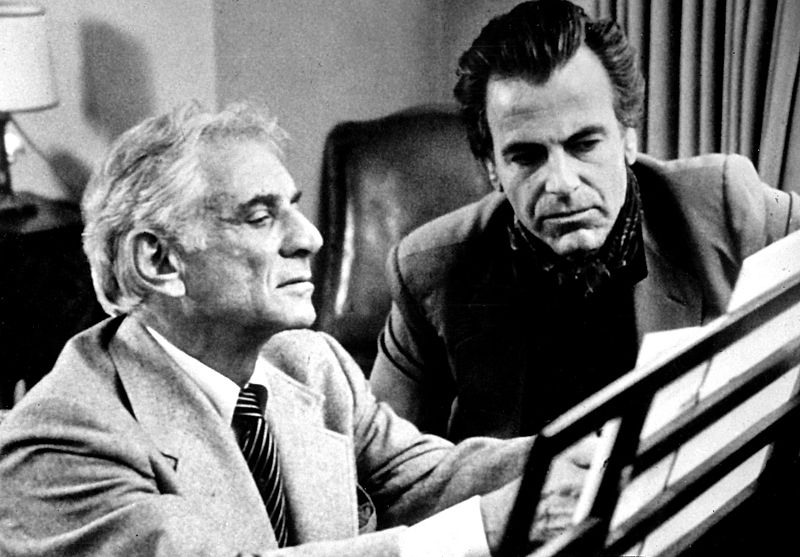”I’m no longer quite sure what the question is, but I do know that the answer is Yes.”
Thus did Leonard Bernstein famously conclude his Norton Lectures on the nature of music at Harvard University, 1973. This year we commemorate the 100th anniversary of Bernstein’s birth Aug. 25, a good time to unpack his statement.
As conductor, as composer, and as mass-media music educator, Bernstein made Western art music more than accessible: He made it understandable. And at the root of this understanding was his idea of faith.
“There are far more than one ‘central theme’ within my body of works,” Bernstein wrote in reply to an inquiry from a fan. “But if I had to choose one, perhaps the most significant, it would be our search for a solution to the 20th century crisis of faith.”
This could be taken to mean that Bernstein spent his life searching for confirmation in the religion of his birth, Judaism, and in some sense that is true. Many of his compositions – among them the first and third symphonies (subtitled Jeremiah and Kaddish, respectively), the Chichester Psalms, the ballet The Dybbuk and his tone poem, Halil – address Jewish subjects and themes. Judaism was of course central to the life of a man raised in the Torah, but as an adult Bernstein was not an observant Jew. His religion became instead the frame of a wider search for faith itself.
What, then, is faith? If not certainty based on revealed dogma, what could it be? Bernstein’s remarkable introductory essay to his book, The Infinite Variety of Music (1966) provides a clue. In it, he addresses the crisis in music that was at that precise moment approaching climax. In 1923, composer/theorist Arnold Schoenberg had reconceived the twelve tones of the Western chromatic scale as “equals.” Previously, classical music – like all music, worldwide, throughout all of history – had treated some notes in a scale as having greater weight than others, forming a web of dissonance and consonance that birthed songs and symphonies. To illustrate this phenomenon for yourself, sing the major scale (“do, re, mi,” etc.) stopping on “ti,” the next-to-last note, and the pull you will feel to sing that last note is the hierarchy of musical pitch at work. This is called “tonality,” and a great deal of ink has been spilled misunderstanding the term. What Schoenberg did by positing the flattened array of pitches called “twelve-tone” music was to assert the belief that it was possible to experience a single pitch as an isolated phenomenon, unrelated to any other pitch, and to build a musical system founded on this belief. Twelve-tone music dominated Western art music in the mid-20th century.
There is one rather serious problem with twelve-tone music, says Bernstein: There can be no such thing. He does not say that twelve-tone music is inferior to other music, or that people shouldn’t write twelve-tone music. He claims that true twelve-tone music cannot exist. Why? Because the ear hears pitched sound as belonging to a harmonic series; the ear automatically infers tonal relations even when the composer intends otherwise. Every pitch stands in relation to other pitches, because it cannot be otherwise to a hearing human. All music is necessarily tonal, not in the sense of conforming to the specific rules of the Western system of tonality, but in the larger sense that every note will inevitably be heard as suggestive of some kind of pitch hierarchy. “We cannot hear two isolated tones…without immediately imputing a tonal meaning to them,” Bernstein wrote, not because our culture gives them a meaning, but because meaning is there in how we, as humans, hear pitched sound.
This condition of trusting our experience to reveal meaning through connectedness is what Bernstein meant by faith. Faith is trust in our finitude. It is the understanding that, despite ourselves, meaning is present. All we have to do is recognize it.
Faith is not just one question among many; rather, it is the return of all questions to the fundamental single question underlying them: What is the nature of questioning? And we can answer that in one of only two ways: 1) To question is a pointless endeavor that reveals the essential meaninglessness of our existence; or 2) To question is to search for meaning, confident that an answer is forthcoming.
To give the latter answer is to proclaim our condition for understanding, the foundation of all faith. It was Bernstein’s Yes to the question of life.
















Leave a Comment
Your email address will not be published. Required fields are marked with *